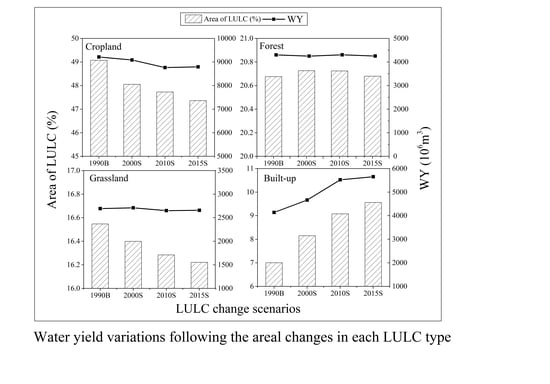Impacts of Land-Use and Land-Cover Changes on Water Yield: A Case Study in Jing-Jin-Ji, China
Abstract
:1. Introduction
2. Materials and Methods
2.1. Study Area
2.2. Data Collection and Processing
2.2.1. Land-Use and Land-Cover (LULC) Change
2.2.2. Input Data for Water Yield (WY) Simulation
2.3. The Integrated Valuation of Ecosystem Services and Tradeoffs (InVEST) Model
2.4. WY Under Four LULC Change Scenarios
2.5. WY Coefficient
3. Results
3.1. InVEST Calibration and Validation
3.2. Annual WY
3.3. Impacts of LULC Changes on WY
3.3.1. Spatial and Temporal LULC Changes
3.3.2. LULC Conversion Matrix
3.3.3. WY Under LULC Change Scenarios
3.3.4. WY Coefficients of LULC Types
4. Discussion
4.1. WY under LULC Changes
4.2. WY Prediction for LULC Planning
4.3. WY and Blue Water Availability: Policy Implication
4.4. Uncertainty of InVEST Model
5. Conclusions
Supplementary Materials
Acknowledgments
Author Contributions
Conflicts of Interest
References
- Sharp, R.; Tallis, H.; Ricketts, T.; Guerry, A.; Wood, S.; Chaplin-Kramer, R.; Nelson, E.; Ennaanay, D.; Wolny, S.; Olwero, N.; et al. InVEST 3.3.2 User’s Guide; The Natural Capital Project: Stanford, CA, USA, 2016. [Google Scholar]
- De Groot, R.S.; Wilson, M.A.; Boumans, R.M. A typology for the classification, description and valuation of ecosystem functions, goods and services. Ecol. Econ. 2002, 41, 393–408. [Google Scholar] [CrossRef]
- DeFries, R.; Eshleman, N.K. Land-use change and hydrologic processes: A major focus for the future. Hydrol. Process. 2004, 18, 2183–2186. [Google Scholar] [CrossRef]
- Foley, J.A.; DeFries, R.; Asner, G.P.; Barford, C.; Bonan, G.; Carpenter, S.R.; Chapin, F.S.; Coe, M.T.; Daily, G.C.; Gibbs, H.K. Global consequences of land use. Science 2005, 309, 570–574. [Google Scholar] [CrossRef] [PubMed]
- Woldesenbet, T.A.; Elagib, N.A.; Ribbe, L.; Heinrich, J. Hydrological responses to land use/cover changes in the source region of the Upper Blue Nile Basin, Ethiopia. Sci. Total Environ. 2017, 575, 724–741. [Google Scholar] [CrossRef] [PubMed]
- Li, Q.F.; Cai, T.; Yu, M.X.; Lu, G.B.; Xie, W.; Bai, X. Investigation into the impacts of land-use change on runoff generation characteristics in the upper huaihe river basin, China. J. Hydrol. Eng. 2013, 18, 1464–1470. [Google Scholar] [CrossRef]
- Im, S.; Kim, H.; Kim, C.; Jang, C. Assessing the impacts of land use changes on watershed hydrology using MIKE SHE. Environ. Geol. 2008, 57, 231–239. [Google Scholar] [CrossRef]
- Tang, L.; Yang, D.; Hu, H.; Gao, B. Detecting the effect of land-use change on streamflow, sediment and nutrient losses by distributed hydrological simulation. J. Hydrol. 2011, 409, 172–182. [Google Scholar] [CrossRef]
- Bent, G.C. Effects of forest-management activities on runoff components and ground-water recharge to Quabbin Reservoir, central Massachusetts. For. Ecol. Manag. 2001, 143, 115–129. [Google Scholar] [CrossRef]
- Brown, A.E.; Zhang, L.; McMahon, T.A.; Western, A.W.; Vertessy, R.A. A review of paired catchment studies for determining changes in water yield resulting from alterations in vegetation. J. Hydrol. 2005, 310, 28–61. [Google Scholar] [CrossRef]
- Sun, G.; Zhou, G.; Zhang, Z.; Wei, X.; McNulty, S.G.; Vose, J.M. Potential water yield reduction due to forestation across China. J. Hydrol. 2006, 328, 548–558. [Google Scholar] [CrossRef]
- Sajikumar, N.; Remya, R.S. Impact of land cover and land use change on runoff characteristics. J. Environ. Manag. 2015, 161, 460–468. [Google Scholar] [CrossRef] [PubMed]
- Wang, G.; Yang, H.; Wang, L.; Xu, Z.; Xue, B. Using the SWAT model to assess impacts of land use changes on runoff generation in headwaters. Hydrol. Process. 2014, 28, 1032–1042. [Google Scholar] [CrossRef]
- Zhou, X.; Zhao, H.; Sun, H. Proper assessment for forest hydrological effect. J. Natl. Resour. 2001, 16, 420–426. [Google Scholar]
- Guswa, A.J.; Brauman, K.A.; Brown, C.; Hamel, P.; Keeler, B.L.; Sayre, S.S. Ecosystem services: Challenges and opportunities for hydrologic modeling to support decision making. Water Resour. Res. 2014, 50, 4535–4544. [Google Scholar] [CrossRef]
- Nelson, E.; Mendoza, G.; Regetz, J.; Polasky, S.; Tallis, H.; Cameron, D.R.; Chan, K.M.A.; Daily, G.C.; Goldstein, J.; Kareiva, P.M.; et al. Modeling multiple ecosystem services, biodiversity conservation, commodity production, and tradeoffs at landscape scales. Front. Ecol. Environ. 2009, 7, 4–11. [Google Scholar] [CrossRef]
- Vorstius, A.C.; Spray, C.J. A comparison of ecosystem services mapping tools for their potential to support planning and decision-making on a local scale. Ecosyst. Serv. 2015, 15, 75–83. [Google Scholar] [CrossRef]
- Berg, C.E.; Mineau, M.M.; Rogers, S.H. Examining the ecosystem service of nutrient removal in a coastal watershed. Ecosyst. Serv. 2016, 20, 104–112. [Google Scholar] [CrossRef]
- Redhead, J.W.; Stratford, C.; Sharps, K.; Jones, L.; Ziv, G.; Clarke, D.; Oliver, T.H.; Bullock, J.M. Empirical validation of the InVEST water yield ecosystem service model at a national scale. Sci. Total Environ. 2016, 569–570, 1418–1426. [Google Scholar] [CrossRef] [PubMed] [Green Version]
- Xie, H.; He, Y.; Xie, X. Exploring the factors influencing ecological land change for China’s Beijing–Tianjin–Hebei region using big data. J. Clean. Prod. 2017, 142, 677–687. [Google Scholar] [CrossRef]
- Liu, J.; Zang, C.; Tian, S.; Liu, J.; Yang, H.; Jia, S.; You, L.; Liu, B.; Zhang, M. Water conservancy projects in China: Achievements, challenges and way forward. Glob. Environ. Chang. 2013, 23, 633–643. [Google Scholar] [CrossRef]
- Zhao, X.; Liu, J.G.; Liu, Q.Y.; Tillotson, M.R.; Guan, D.B.; Hubacek, K. Physical and virtual water transfers for regional water stress alleviation in China. Proc. Natl. Acad. Sci. USA 2015, 112, 1031–1035. [Google Scholar] [CrossRef] [PubMed]
- Cai, J.L.; Varis, L.; Yin, H. China’s water resources vulnerability: A spatio-temporal analysis during 2003–2013. J. Clean. Prod. 2017, 142, 2901–2910. [Google Scholar] [CrossRef]
- Hebei Statistic Bureau (HBTJ). Hebei Economic Statistical Yearbook 2016. Available online: http://www.hetj.gov.cn/res/nj2016/indexch.htm (accessed on 15 November 2017). (In Chinese)
- Feng, Z.; Liu, D. A study on water resources carrying capacity in Jingjinji region. J. Natl. Resour. 2006, 21, 689–699. (In Chinese) [Google Scholar]
- Haihe River Water Resource Conservance Commission (HWCC). Haihe River Water Resources Bulletin. Available online: http://www.hwcc.gov.cn/hwcc/wwgj/xxgb/szygb/ (accessed on 26 November 2017).
- Bao, C.; He, D. Spatiotemporal characteristics of water resources exploitation and policy implications in the Beijing-Tianjin-Hebei Urban Agglomeration (in Chinese). Prog. Geogr. 2017, 36, 58–67. [Google Scholar]
- Zhou, X.; Bai, Z.; Yang, Y. Linking trends in urban extreme rainfall to urban flooding in China. Int. J. Clim. 2017. [Google Scholar] [CrossRef]
- Lu, S.; Wu, B.; Wei, Y.; Yan, N.; Wang, H.; Guo, S. Quantifying impacts of climate variability and human activities on the hydrological system of the Haihe River Basin, China. Environ. Earth Sci. 2014, 73, 1491–1503. [Google Scholar] [CrossRef]
- Chen, F.L.; Li, J.Z. Quantifying drought and water scarcity: A case study in the Luanhe river basin. Nat. Hazards 2016, 81, 1913–1927. [Google Scholar] [CrossRef]
- Zhan, C.; Xu, Z.; Ye, A.; Su, H. LUCC and its impact on run-off yield in the Bai River catchment—Upstream of the Miyun Reservoir basin. J. Plant Ecol. 2011, 4, 61–66. [Google Scholar] [CrossRef]
- Wang, G.; Xia, J.; Chen, J. Quantification of effects of climate variations and human activities on runoff by a monthly water balance model: A case study of the Chaobai River basin in northern China. Water Resour. Res. 2009, 45. [Google Scholar] [CrossRef] [Green Version]
- Bai, Y.; Jiang, B.; Alatalo, J.M.; Zhuang, C.W.; Wang, X.Y.; Cui, L.J.; Xu, W.H. Impacts of land management on ecosystem service delivery in the Baiyangdian river basin. Environ. Earth Sci. 2016, 75. [Google Scholar] [CrossRef]
- Zhao, D.; Tang, Y.; Liu, J.; Tillotson, M.R. Water footprint of Jing-Jin-Ji urban agglomeration in China. J. Clean. Prod. 2017, 167, 919–928. [Google Scholar] [CrossRef]
- Mao, H. Innovation of mechanism and regional policy for promoting coordinated development of Beijing-Tianjin-Hebei. Prog. Geogr. 2017, 36, 2–14. (In Chinese) [Google Scholar]
- Cetin, M. Determining the bioclimatic comfort in Kastamonu City. Environ. Monit. Assess. 2015, 187. [Google Scholar] [CrossRef] [PubMed]
- Ceti̇n, M. Evaluation of the sustainable tourism potential of a protected area for landscape planning: A case study of the ancient city of Pompeipolis in Kastamonu. Int. J. Sustain. Dev. World 2015, 22, 490–495. [Google Scholar] [CrossRef]
- Lawler, J.J.; Lewis, D.J.; Nelson, E.; Plantinga, A.J.; Polasky, S.; Withey, J.C.; Helmers, D.P.; Martinuzzi, S.; Pennington, D.; Radeloff, V.C. Projected land-use change impacts on ecosystem services in the United States. Proc. Natl. Acad. Sci. USA 2014, 111, 7492–7497. [Google Scholar] [CrossRef] [PubMed]
- Deng, X.; Gibson, J.; Wang, P. Relationship between landscape diversity and crop production: A case study in the Hebei Province of China based on multi-source data integration. J. Clean. Prod. 2017, 142, 985–992. [Google Scholar] [CrossRef]
- Cetin, M. Using GIS analysis to assess urban green space in terms of accessibility: Case study in Kutahya. Int. J. Sust. Dev. World 2015, 22, 420–424. [Google Scholar] [CrossRef]
- Cetin, M.; Adiguzel, F.; Kaya, O.; Sahap, A. Mapping of bioclimatic comfort for potential planning using GIS in Aydin. Environ. Dev. Sustain. 2016, 20, 361–375. [Google Scholar] [CrossRef]
- Ceti̇n, M.; Sevi̇k, H. Evaluating the recreation potential of Ilgaz Mountain National Park in Turkey. Environ. Monit. Assess. 2016, 188. [Google Scholar] [CrossRef] [PubMed]
- National Bureau of Statistics of China (NBSC). China Statistical Yearbook. Available online: http://www.stats.gov.cn/tjsj/ndsj/ (accessed on 26 November 2017). (In Chinese)
- State Forestry Agency (SFA). China Wetlands Resources; China Forestry Press: Beijing, China, 2015.
- Liu, J.; Kuang, W.; Zhang, Z.; Xu, X.; Qin, Y.; Ning, J.; Zhou, W.; Zhang, S.; Li, R.; Yan, C. Spatiotemporal characteristics, patterns, and causes of land-use changes in China since the late 1980s. J. Geogr. Sci. 2014, 24, 195–210. [Google Scholar] [CrossRef]
- Davis, T.J. The Ramsar Convention Manual: A Guide to the Convention on Wetlands of International Importance Especially as Waterfowl Habitat; Ramsar Convention Bureau: Gland, Switzerland, 1994. [Google Scholar]
- China Meteorological Data Service Center (CMDC). Available online: http://data.cma.cn/ (accessed on 1 June 2017).
- Allen, R.G.; Pereira, L.S.; Raes, D.; Smith, M. Crop Evapotranspiration-Guidelines for Computing Crop Water Requirements-FAO Irrigation and Drainage Paper 56; FAO: Rome, Italy, 1998. [Google Scholar]
- Shangguan, W.; Dai, Y.; Liu, B.; Zhu, A.; Duan, Q.; Wu, L.; Ji, D.; Ye, A.; Yuan, H.; Zhang, Q.; et al. A China data set of soil properties for land surface modeling. J. Adv. Model. Earth Syst. 2013, 5, 212–224. [Google Scholar] [CrossRef]
- Zhou, W.; Liu, G.; Pan, J.; Feng, X. Distribution of available soil water capacity in China. J. Geogr. Sci. 2005, 15, 3–12. [Google Scholar] [CrossRef]
- Shukla, A.K.; Pathak, S.; Ojha, C.S.P.; Mijic, A.; Garg, R.D. Spatio-temporal assessment of annual water-balance model for Upper Ganga Basin. Hydrol. Earth Syst. Sci. Dis. 2017, 536, 1–29. [Google Scholar] [CrossRef]
- Goyal, M.K.; Khan, M. Assessment of spatially explicit annual water-balance model for Sutlej River Basin in eastern Himalayas and Tungabhadra River Basin in peninsular India. Hydrol. Res. 2017, 48, 542–558. [Google Scholar] [CrossRef]
- Hamel, P.; Guswa, A.J. Uncertainty analysis of a spatially explicit annual water-balance model: Case study of the Cape Fear basin, North Carolina. Hydrol. Earth Syst. Sci. 2015, 19, 839–853. [Google Scholar] [CrossRef]
- Goel, M.K. Runoff Coefficient. Encyclopedia of Snow, Ice and Glaciers; Springer: Dordrecht, The Netherlands, 2011. [Google Scholar]
- Wheeler, R.E. Permutation tests for linear models in R. Compr. R Arch. Netw. 2010, 1, 1–2. [Google Scholar]
- Wang, T.; Lv, C. Quantitative structural analysis on land use change in Beijing-Tianjin-Hebei Region. J. Shanxi Univ. 2010, 33, 473–478. (In Chinese) [Google Scholar]
- Im, S.; Brannan, K.M.; Mostaghimi, S. Simulating hydrologic and water quality impacts in an urbanizing watershed. J. Am. Water Resour. Assoc. 2003, 39, 1465–1479. [Google Scholar] [CrossRef]
- Sanchez-Canales, M.; Lopez Benito, A.; Passuello, A.; Terrado, M.; Ziv, G.; Acuna, V.; Schuhmacher, M.; Elorza, F.J. Sensitivity analysis of ecosystem service valuation in a Mediterranean watershed. Sci. Total Environ. 2012, 440, 140–153. [Google Scholar] [CrossRef] [PubMed]
- Bangash, R.F.; Passuello, A.; Sanchez-Canales, M.; Terrado, M.; López, A.; Elorza, F.J.; Ziv, G.; Acuña, V.; Schuhmacher, M. Ecosystem services in Mediterranean river basin: Climate change impact on water provisioning and erosion control. Sci. Total Environ. 2013, 458, 246–255. [Google Scholar] [CrossRef] [PubMed]
- Sahin, V.; Hall, M.J. The effects of afforestation and deforestation on water yields. J. Hydrol. 1996, 178, 293–309. [Google Scholar] [CrossRef]
- Bi, H.; Liu, B.; Wu, J.; Yun, L.; Chen, Z.; Cui, Z. Effects of precipitation and landuse on runoff during the past 50 years in a typical watershed in Loess Plateau, China. Int. J. Sediment Res. 2009, 24, 352–364. [Google Scholar] [CrossRef]
- Zhang, L.; Dawes, W.; Walker, G. Response of mean annual evapotranspiration to vegetation changes at catchment scale. Water Resour. Res. 2001, 37, 701–708. [Google Scholar] [CrossRef]
- Arunyawat, S.; Shrestha, R. Assessing land use change and its impact on ecosystem services in northern Thailand. Sustainability 2016, 8, 768. [Google Scholar] [CrossRef]
- Jujnovsky, J.; Ramos, A.; Caro-Borrero, A.; Mazari-Hiriart, M.; Maass, M.; Almeida-Lenero, L. Water assessment in a peri-urban watershed in Mexico City: A focus on an ecosystem services approach. Ecosyst. Serv. 2017, 24, 91–100. [Google Scholar] [CrossRef]
- Liu, Y.Y.; Zhang, X.N.; Xia, D.Z.; You, J.S.; Rong, Y.S.; Bakir, M. Impacts of land-use and climate changes on hydrologic processes in the qingyi river watershed, China. J. Hydrol. Eng. 2013, 18, 1495–1512. [Google Scholar] [CrossRef]
- Yang, C.G.; Yu, Z.B.; Hao, Z.C.; Lin, Z.H.; Wang, H.M. Effects of vegetation cover on hydrological processes in a large region: Huaihe river basin, China. J. Hydrol. Eng. 2013, 18, 1477–1483. [Google Scholar] [CrossRef]
- Zhao, G.J.; Mu, X.M.; Jiao, J.Y.; An, Z.F.; Klik, A.; Wang, F.; Jiao, F.; Yue, X.L.; Gao, P.; Sun, W.Y. Evidence and causes of spatiotemporal changes in runoff and sediment yield on the Chinese Loess plateau. Land Degrad. Dev. 2017, 28, 579–590. [Google Scholar] [CrossRef]
- Millennium Ecosystem Assessment. Ecosystems and Human Well-Being: Wetlands and Water; World Resources Institute: Washington, DC, USA, 2005. [Google Scholar]
- Li, Y.F.; Luo, Y.C.; Liu, G.; Ouyang, Z.Y.; Zheng, H. Effects of land use change on ecosystem services, a case study in Miyun reservoir watershed. Acta Ecol. Sin. 2013, 33, 726–736. (In Chinese) [Google Scholar]
- Geng, X.L.; Wang, X.S.; Yan, H.M.; Zhang, Q.; Jin, G. Land use/land cover change induced impacts on water supply service in the upper reach of Heihe River Basin. Sustainability 2015, 7, 366–383. [Google Scholar] [CrossRef]
- Cetin, M. Sustainability of urban coastal area management: A case study on Cide. J. Sustain. For. 2016, 35, 527–541. [Google Scholar] [CrossRef]
- Liu, M.; Tian, H.; Chen, G.; Ren, W.; Zhang, C.; Liu, J. Effects of land-use and land-cover change on evapotranspiration and water yield in china during 1900–2000. J. Am. Water Resour. Assoc. 2008, 44, 1193–1207. [Google Scholar] [CrossRef]
- Brauman, K.A.; Daily, G.C.; Duarte, T.K.E.; Mooney, H.A. The nature and value of ecosystem services: An overview highlighting hydrologic services. Annu. Rev. Environ. Resour. 2007, 32, 67–98. [Google Scholar] [CrossRef]
- Brauman, K.A.; Freyberg, D.L.; Daily, G.C. Land cover effects on groundwater recharge in the tropics: Ecohydrologic mechanisms. Ecohydrology 2012, 5, 435–444. [Google Scholar] [CrossRef]
- Andréassian, V. Waters and forests: From historical controversy to scientific debate. J. Hydrol. 2004, 291, 1–27. [Google Scholar] [CrossRef]
- Xu, W.H.; Xiao, Y.; Zhang, J.J.; Yang, W.; Zhang, L.; Hull, V.; Wang, Z.; Zheng, H.; Liu, J.G.; Polasky, S.; et al. Strengthening protected areas for biodiversity and ecosystem services in China. Proc. Natl. Acad. Sci. USA 2017, 114, 1601–1606. [Google Scholar] [CrossRef] [PubMed]
- Hu, Q.-L.; Qi, Y.-Q.; Hu, Y.-C.; Zhang, Y.-C.; Wu, C.-B.; Zhang, G.-L.; Shen, Y.-J. Changes and driving forces of land use/cover and landscape patterns in Beijing-Tianjin-Hebei region. Chin. J. Eco-Agric. 2011, 19, 1182–1189. (In Chinese) [Google Scholar] [CrossRef]
- Liu, J.; Yang, W. Water sustainability for China and beyond. Science 2012, 337, 649–650. [Google Scholar] [CrossRef] [PubMed]
- Palmer, M.A.; Liu, J.; Matthews, J.H.; Mumba, M.; D’odorico, P. Manage water in a green way. Science 2015, 349, 584–585. [Google Scholar] [CrossRef] [PubMed]
- Shao, W.; Zhang, H.; Liu, J.; Yang, G.; Chen, X.; Yang, Z.; Huang, H. Data integration and its application in the sponge city construction of China. Procedia Eng. 2016, 154, 779–786. [Google Scholar] [CrossRef]
- Goldstein, J.H.; Caldarone, G.; Duarte, T.K.; Ennaanay, D.; Hannahs, N.; Mendoza, G.; Polasky, S.; Wolny, S.; Daily, G.C. Integrating ecosystem-service tradeoffs into land-use decisions. Proc. Natl. Acad. Sci. USA 2012, 109, 7565–7570. [Google Scholar] [CrossRef] [PubMed]
- Chen, L.; Xie, G.; Zhang, C.; Pei, S.; Fan, N.; Ge, L.; Zhang, C. Modelling ecosystem water supply services across the Lancang River Basin. J. Resour. Ecol. 2011, 2, 322–327. [Google Scholar]
- Xiao, Y.; Xiao, Q.; Ouyang, Z.Y.; Qin, M.M. Assessing changes in water flow regulation in Chongqing region, China. Environ. Monit. Assess. 2015, 187, 1–13. [Google Scholar] [CrossRef] [PubMed]
- Boithias, L.; Acuna, V.; Vergonos, L.; Ziv, G.; Marce, R.; Sabater, S. Assessment of the water supply: Demand ratios in a Mediterranean basin under different global change scenarios and mitigation alternatives. Sci. Total Environ. 2014, 470, 567–577. [Google Scholar] [CrossRef] [PubMed]
- Terrado, M.; Acuna, V.; Ennaanay, D.; Tallis, H.; Sabater, S. Impact of climate extremes on hydrological ecosystem services in a heavily humanized Mediterranean basin. Ecol. Indic. 2014, 37, 199–209. [Google Scholar] [CrossRef]

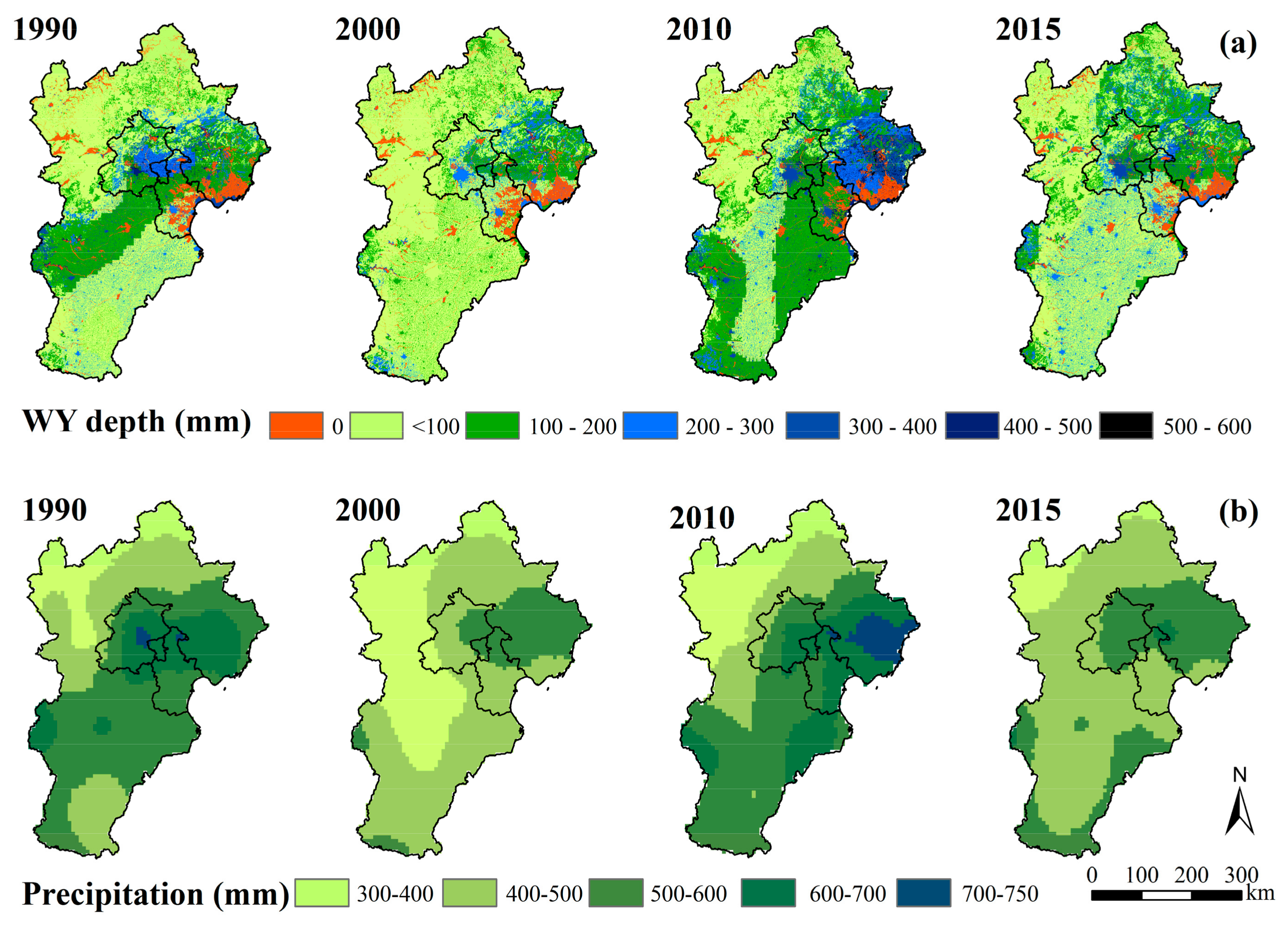
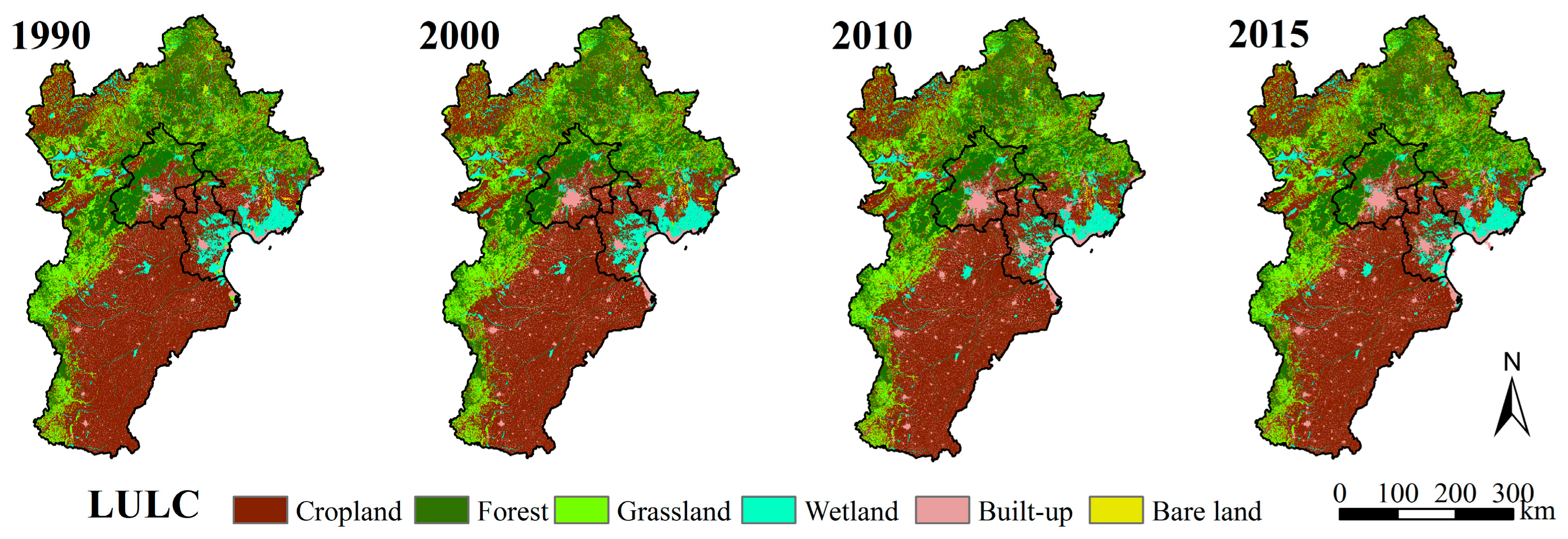
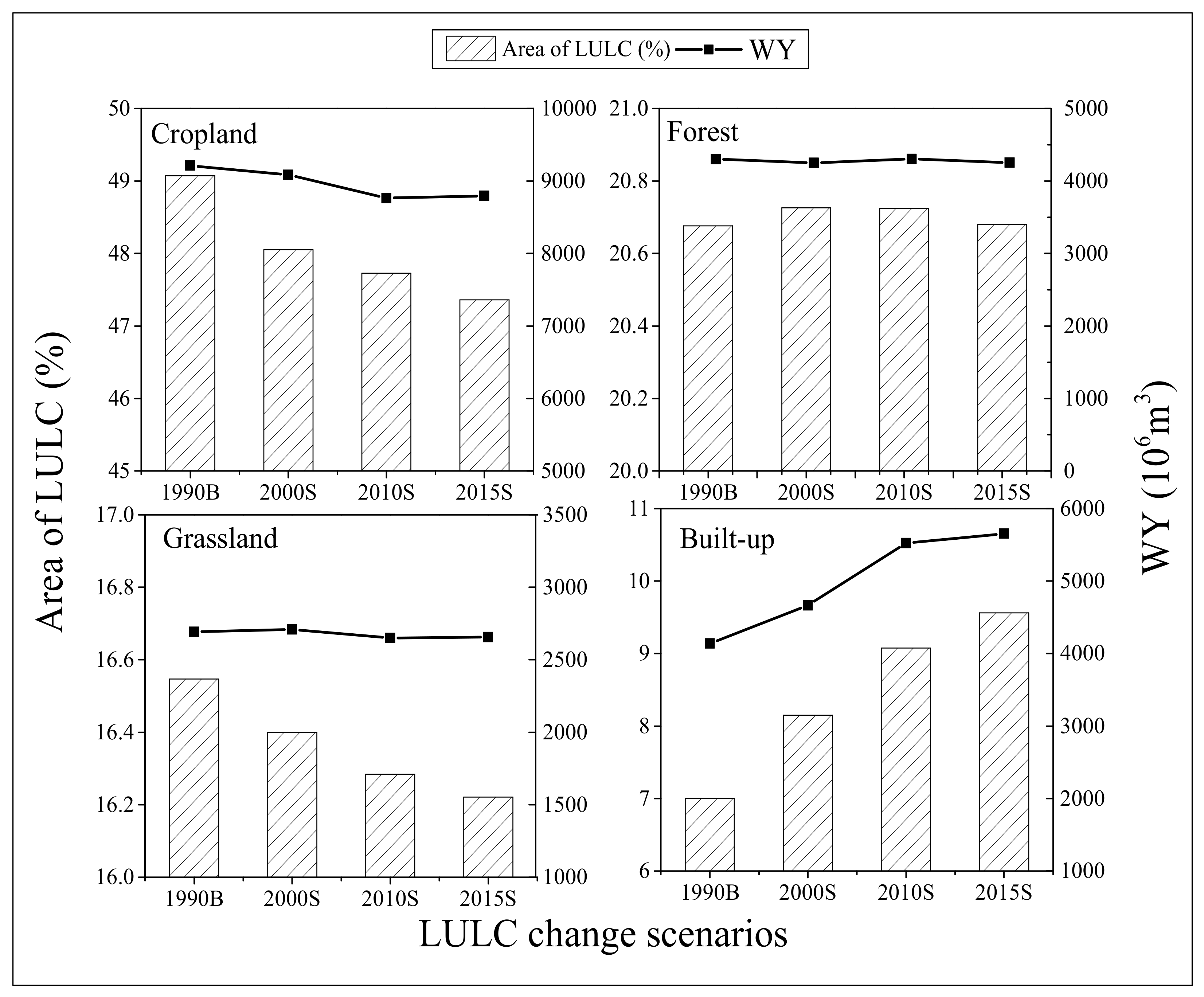
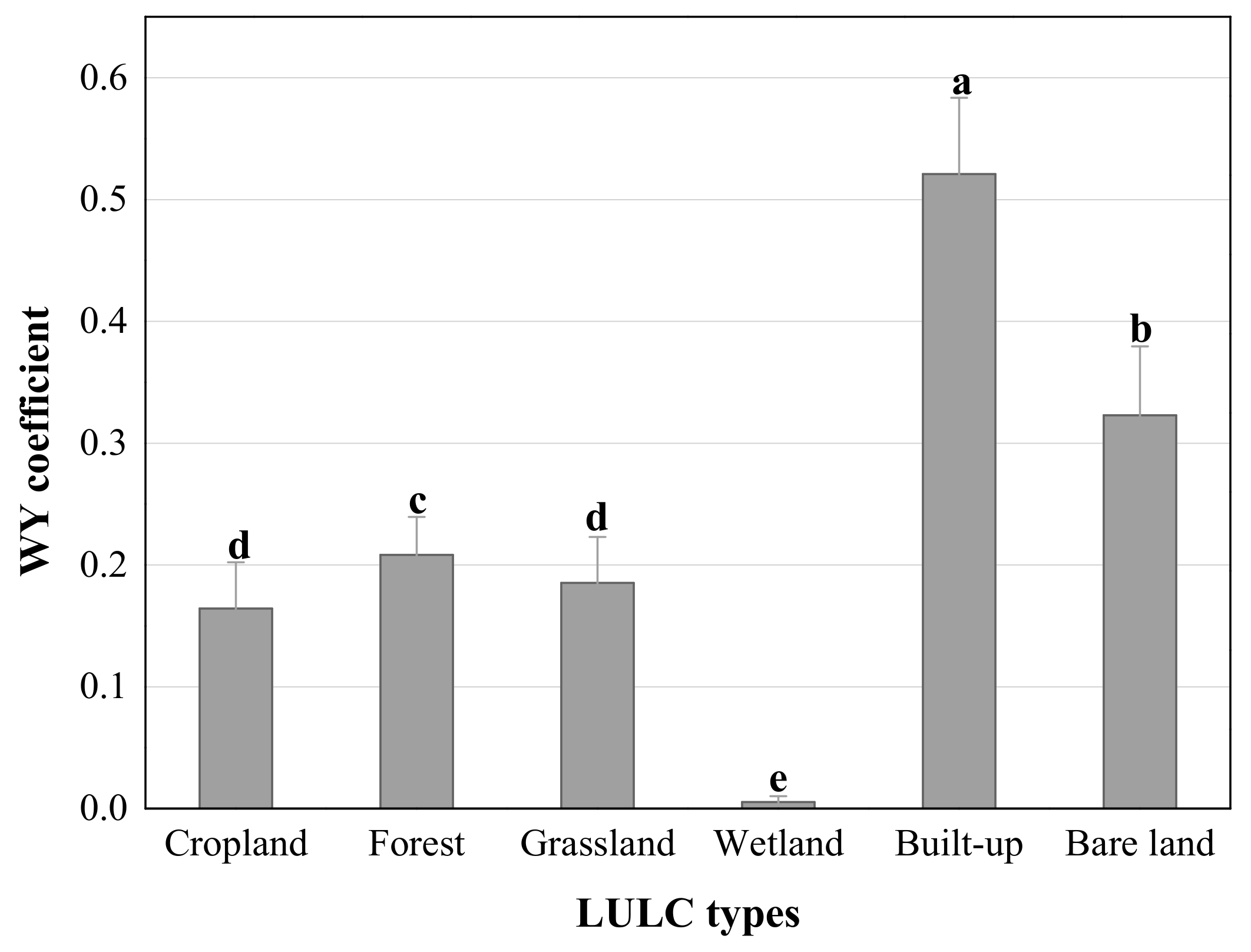
| Year | 1990 | 2000 | 2010 | 2015 | Changes between 1990 and 2015 | |||||
|---|---|---|---|---|---|---|---|---|---|---|
| LULC | km2 | % | km2 | % | km2 | % | km2 | % | km2 | % |
| Cropland | 105,734 | 49.07 | 103,431 | 48.05 | 102,732 | 47.73 | 102,146 | 47.36 | −3588 | −3.40 |
| Forest | 44,549 | 20.68 | 44,611 | 20.73 | 44,607 | 20.72 | 44,600 | 20.68 | 51 | 0.11 |
| Grassland | 35,652 | 16.55 | 35,298 | 16.40 | 35,051 | 16.28 | 34,985 | 16.22 | −667 | −1.87 |
| Wetland | 13,498 | 6.26 | 13,435 | 6.24 | 12,443 | 5.78 | 12,452 | 5.77 | −1046 | −7.75 |
| Built-up | 15,086 | 7.00 | 17,538 | 8.15 | 19,535 | 9.08 | 20,466 | 9.50 | 5380 | 35.66 |
| Bare land | 949 | 0.44 | 931 | 0.43 | 880 | 0.41 | 868 | 0.40 | −81 | −8.54 |
| 2015 a | Cropland | Forest | Grassland | Wetland | Built-up | Bare Land | |||||||
|---|---|---|---|---|---|---|---|---|---|---|---|---|---|
| 1990 b | km2 | % | km2 | % | km2 | % | km2 | % | km2 | % | km2 | % | 1990 Total |
| Cropland | 100,632 | 95.17 | 244 | 0.23 | 32 | 0.03 | 468 | 0.44 | 4333 | 4.1 | 26 | 0.02 | 105,734 |
| Forest | 138 | 0.31 | 44,171 | 99.15 | 83 | 0.19 | 10 | 0.02 | 147 | 0.33 | 0 | 0 | 44,549 |
| Grassland | 298 | 0.84 | 149 | 0.42 | 34,833 | 97.7 | 88 | 0.25 | 281 | 0.79 | 3 | 0.01 | 35,652 |
| Wetland | 1005 | 7.45 | 34 | 0.25 | 21 | 0.16 | 11,792 | 87.36 | 642 | 4.76 | 4 | 0.03 | 13,498 |
| Built-up | 45 | 0.3 | 2 | 0.01 | 5 | 0.04 | 26 | 0.17 | 15,008 | 99.48 | 0 | 0 | 15,086 |
| Bare land | 27 | 2.89 | 1 | 0.13 | 10 | 1.02 | 21 | 2.17 | 55 | 5.78 | 835 | 88.01 | 949 |
| 2015 total | 102,146 | - | 44,600 | - | 34,984 | - | 12,405 | - | 20,466 | - | 868 | - | - |
| Change | −3588 | - | 51 | - | −667 | - | −1093 | - | 5380 | - | −81 | - | - |
| Change (%) | −3.4 | - | 0.11 | - | −1.87 | - | −8.1 | - | 35.66 | - | −8.54 | - | - |
| LULC | 1990B | 2000S | 2010S | 2015S | Average AET (mm) | ||||
|---|---|---|---|---|---|---|---|---|---|
| WY | WY | WY | WY | ||||||
| (109 m3) | % | (109 m3) | % | (109 m3) | % | (109 m3) | % | ||
| Cropland | 9.21 | 45 | 9.09 | 43 | 8.77 | 41 | 8.80 | 41 | 425 |
| Forest | 4.30 | 21 | 4.25 | 21 | 4.31 | 20 | 4.26 | 20 | 468 |
| Grassland | 2.69 | 13 | 2.71 | 13 | 2.65 | 12 | 2.66 | 12 | 425 |
| Built-up | 4.14 | 20 | 4.67 | 22 | 5.53 | 26 | 5.65 | 26 | 244 |
| Bare land | 0.11 | 1 | 0.11 | 1 | 0.11 | 1 | 0.11 | 1 | 414 |
| WY total | 20.50 | 100 | 20.97 | 100 | 21.43 | 100 | 21.55 | 100 | - |
© 2018 by the authors. Licensee MDPI, Basel, Switzerland. This article is an open access article distributed under the terms and conditions of the Creative Commons Attribution (CC BY) license (http://creativecommons.org/licenses/by/4.0/).
Share and Cite
Li, S.; Yang, H.; Lacayo, M.; Liu, J.; Lei, G. Impacts of Land-Use and Land-Cover Changes on Water Yield: A Case Study in Jing-Jin-Ji, China. Sustainability 2018, 10, 960. https://doi.org/10.3390/su10040960
Li S, Yang H, Lacayo M, Liu J, Lei G. Impacts of Land-Use and Land-Cover Changes on Water Yield: A Case Study in Jing-Jin-Ji, China. Sustainability. 2018; 10(4):960. https://doi.org/10.3390/su10040960
Chicago/Turabian StyleLi, Suxiao, Hong Yang, Martin Lacayo, Junguo Liu, and Guangchun Lei. 2018. "Impacts of Land-Use and Land-Cover Changes on Water Yield: A Case Study in Jing-Jin-Ji, China" Sustainability 10, no. 4: 960. https://doi.org/10.3390/su10040960




